- Details
- Denis Giles
- Hits: 1965
![]()
The Andaman Islands are one of the few places in India where individuals from multiple communities are involved in commercial fishing activities. At the same time several different types of fisheries came into existence since the 1900s. The previously pristine nature of marine ecosystems in these islands and their extensive fringing coral reefs, created a space for multiple fisheries targeting different types of marine organisms. However, these fisheries have not had a stable history of existence. Many fisheries have peaked and then subsequently declined either due to unregulated fishing pressure, changes in policy, poor management, or a fall in demand for the product. It is worthwhile trying to record this cycle of “boom and bust” fisheries and understand the conditions that allow for new fisheries to start, peak, and then decline.
One of the first commercial fisheries to start in these islands was the shellfish fishery; and two species were mainly targeted, namely Trochus niloticus and Turbo marmoratus. Trochus or ‘top shell’ has a conical shell with alternating red and white bands, while Turbo or ‘turban shell’ has a thick green shell with white patches. Both shells were used in the mother of pearl industry. The fishery started in the 1920s, with licenced Japanese fishers being allowed to skin dive and hand pick the shells off reefs that were 10 to 25m deep. Despite several rules and regulations managing the fishery, including demarcation of shell fishing zones, a minimum size limit, and several closed seasons, the stocks of both species dwindled over the years. In fact, surveys in 1978 by the CMFRI and in 2010 by the ZSI failed to record any specimens of Turbo. In 2001, Trochus and Turbo were placed under the Wildlife Protection Act, 1972, thereby banning collection of these species across India, and this resulted in the closure of the fishery. Sea cucumbers belong to a group called Holothurians, and there was an active fishery for this group since 1975. Sea cucumbers were handpicked from reefs, boiled and dried, to produce an end product called bêche-de-mer that were exported to Singapore, China, Hong Kong, and other Asian countries. Products from the Andaman Islands fetched 10-15 times more money than those from mainland India, due to their high quality. As a result of a clause in the Andaman and Nicobar Islands Shell Fishing Rules, 1978, extraction of sea cucumbers was banned in areas demarcated as ‘Shell Fishing Zones’, which covered nearly all of the area where these organisms were located. There are no clear estimates of the quantities of holothurians extracted from the Andamans, and extensive poaching is partially responsible for this. In 2001, Holothurians were also added to the Wildlife Protection Act, 1972, effectively protecting them from any form of extraction in India.
The first reported landing of sharks in the Andaman Islands was in 1967. Despite the poor local demand for sharks, they were targeted predominantly for their fins and livers. Shark fins were and continue to be exported in large quantities to Southeast Asian countries, while oils from their livers are used for pharmaceutical purposes. The catch rates of sharks in these waters show a declining trend between 1984 and 2005 and fishermen support this trend with observations of reef sharks rarely being encountered nowadays. Some laws and regulations have attempted to regulate this fishery, and a nationwide ban on shark fishing was introduced in July 2001. Six months later this ban was lifted, following protests by shark fishermen across the country. In these islands, a ban on shark fishing from April 15 to May 31 was introduced in 2009, giving shark populations a chance to recover from fishing mortality each year. While the shark fishery is still active in the Andaman Islands, the stocks of coastal species have greatly reduced and fishermen are fishing in deeper and deeper waters in order to catch sharks.
The three fisheries described above have “boomed and busted” due to a combination of factors like poor management, policy changes, and unregulated fishing pressure. Foreign poachers target all three groups to maximise their returns, and in turn deprive local enterprises of profits. With this in mind, several groups advocate the delisting and reopening of the shellfish and sea cucumber fisheries, as they feel that these stocks have recovered appropriately. However, without adequate monitoring of these fisheries and scientifically sound management practices, these fisheries could once again boom and go bust. In order for fishers to self-regulate, a system of equitable profit distribution may go a long way in sustaining these stocks. In the case of the shark fishery, species level catch monitoring, studies on life history patterns, population structure, and abundance could help provide information about the future of these stocks and the direction the fishery is taking. At present, several other fisheries, like those for crabs, lobsters, and groupers, are booming. It only remains to be seen how long these fisheries will last and when they will go bust.
- Details
- Denis Giles
- Hits: 6234
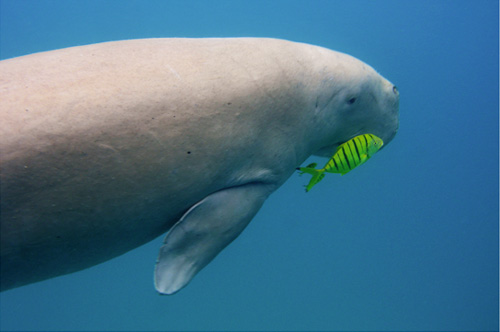
--Vardhan Patankar
Our love, passion, appreciation and realization of the importance of our surrounding environment and wildlife have resulted in actions to safeguard our environment. We often take it for granted that, the Forest Department and NGO’s, albeit inefficient, are protecting our Forest and wildlife. However, the grittier reality is that the wildlife protection is a complicated issue and a number of factors are involved in conserving wildlife, including support and help from the local communities. Such is the case with conserving the State Animal of our islands—the dugongs (Sea Cows).
Dugongs are the only herbivorous mammals that are strictly marine, and the only surviving species in the family Dugongidae. They feed exclusively on sea grass and play a role of kin gardener of sea grass meadows. Unlike many other marine animals, dugongs live up to 70 years and much like humans, reach sexual maturity between 10 and 17 years. A female gives birth to a single calf every 5-7 years and the young ones depend on the mother for a year and a half, which means that the population growth is very low, making it difficult to re-establish or propagate when the population dips to extremely low levels.
There used to be two other species of sea cows - manatee and Stellar’ sea cow. A few individuals of manatees still inhabit the south-eastern coast of the United States, South America and tropical West Africa. However, Stellar’ sea cow was hunted to extinction just twenty-seven years after its discovery in the 18th Century.
Today, dugongs are on the verge of extinction across most of the Indo-Pacific regions. In India, the present distribution of dugongs is restricted along the Gulf of Kutch, the west coast, Gulf of Mannar, the Palk Bay region, and the Andaman and Nicobar Islands. In the Lakshadweep waters, dugongs were driven to local extinction around 60 years ago.
In Andaman and Nicobar islands, a popular belief is that dugongs are found only along “Dugong Creek” in the Little Andaman Island. Our research findings tell us that although few in number, they are reported from other parts such as the Ritchies archipelago (Neil and Havelock group of islands), South Andaman (along Tarmugli, Jollybuoy and Rutland islands), North and middle Andaman (along White-Cliff, Reef, Landfall islands and Mayabundar region), in Hutbay and along the central group of Nicobar Islands.
In our waters, they are unflatteringly referred to as sea-pigs or pani-suwar (thawtee). The name probably arising from their portliness (body size/ structure) may not sound very pleasant, but these animals possess this feature for their survival. The thickest part of their body is the back, where most of the blubber is deposited. Dugongs protect themselves from predators, such as sharks, by simply turning their backs on them.
They may be able to flee from sharks in the water, but their sluggish behaviour makes them easily vulnerable to poachers’ traps. Being mammals, dugongs breathe through lungs and need to surface every 5-6 minutes to breathe. When a dugong is caught in a net, the net traps them not allowing them the gulp of air that they need. Targeted hunting, entanglements in fishing nets and high-speed boat traffic has wreaked havoc to their population across.
Dugongs are listed as vulnerable to extinction by the International Union for Conservation of Nature (IUCN), and the Indian Wildlife Protection Act has accorded them the highest level of legal protection under Schedule I. The Ministry of Environment and Forest, Government of India has launched the Dugong Species Recovery Program.
Are such bans effective tools for conserving species? Are these measures enough?
There are about fifty dugongs that live in the Andaman and Nicobar region! The Forest Department and Nature Conservation Foundation in collaboration with the Andaman and Nicobar Environment team are attempting to conserve these animals. Identifying the habitats of this elusive species and creating awareness amongst local people like the fishermen, boat owners and others to reduce poaching-related threats is the first step towards conserving these docile sea mammals.
Dugong hunting practices continues to exist to date and their habitats are continuously degrading. It’s a great privilege and a matter of pride that such elusive charismatic species choose the waters around our archipelago as their habitat. It is not the Forest Department and the NGO’s who can protect these dugongs, but us – the people who have the power to conserve the measly population and prevent another species from biting the dust. Dugongs if not for anything else, must be conserved for their beauty, rarity and for our children to see what truly belongs to the islands.
- Details
- Denis Giles
- Hits: 2744
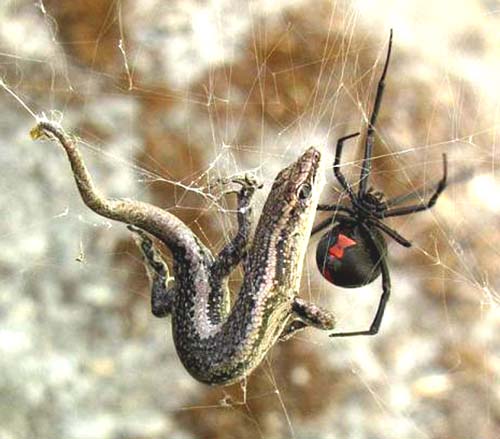
Spiders are not insects, although they belong to the same phylum of animals as insects. Spiders have four pairs of legs and two body segments, they do not have wings or antennae. Spiders belong to the class Arachnida while insects belong to the class Insecta. Spiders are closely related to scorpions, ticks and mites. There are about 37,000 of known species of spiders in the world. Spiders vary in size from the 10 inched bird-eating tarantulas of the rain forest to as small as pin point (0.37 mm) as in Patu digua, a spider of Columbia and they vary widely in colour. The Spider Wasp is the biggest predator of Spider species. The blood of a Spider is light blue in color. They are found everywhere; in soil, under rocks, on grasses, on tree branches, in caves, in your garden or even in your restrooms. Many spiders only live for one or two years, but some like tarantulas live for about 20 years.
Silk: Spiders have glands that make silk. The strongest material in the world is considered as the silk that spiders create. Scientists have not been able to recreate this design even with all the available technology that we have today. The silk is used to capture prey in elaborately woven webs, to wrap and protect eggs and as a bungee cord to move from place to place.
Venom: Spiders are carnivorous and feed on living prey. They crush the prey with processes on the pedipalps, and the chelicerae and have glands that can inject a venom. The bite of some large spiders are painful, but most species are too small to break human skin and only a few are dangerous to humans. Black widow spider is one of the poisonous species, they are nonaggressive and bite humans only in defense. Their painful bite is followed by faintness, difficulty in breathing; although the bite sometime leads to death. Spider venom are neurotoxins, which affects the victims nervous system, typically resulting in paralysis. Some injects cytotoxins that affect the cell tissue. There were about 100 reliably reported deaths from spider bites.
Benefits to humans: Cooked tarantula spiders are considered a delicacy in Cambodia, where the venom gland and outer hairs are removed before cooking. Most spiders are helpful to humans by killing insects harmful to animals and plants. Spider venoms are found to be less polluting alternative to conventional pesticides as they are deadly to insects. Possible medical uses for spider venoms are being investigated for the treatment of cardiac arrhythmia, Alzheimer's disease and strokes. Fine transparent spider silk fibers are used by scientists working on optical communications to introduce minute diffraction patterns over propagating N-slit interferometric signals.
Contributed by: Dr. J. Benjamin Franklin, Scientist, NIOT, Port Blair.
- Details
- Denis Giles
- Hits: 6543
The Sippi Ghat Tragedy OR Loosing Sippi Ghat Again
Wetland. The very word has quite the opposite effect on environmentalists as opposed to developers. Places like swamps and bogs that seem unfit for human habitation,have been witnessing "reclamation" and these magnificent ecosystems are being transformed into land usable for construction. What beauty and natural utility is being lost in the process! These rich, usually soggy places provide critical habitat for numerous species, they help clean our water, control floods, and provide plenty of food for humans.
“Development is essential. Doing it in a planned and structured manner with sensitivity is imperative.” For a development to be sustainable, it is essential to keep in mind the following points.
Purpose of development – Clarity on the purpose of development is essential for site selection and other factors that determine its functionality. Who is the development for and will it have any repercussions? Is there a need for it?;Accessibility – Approach to the site. Are the approach roads designed to take the operation load? ; Geography/ Topography – the lay of land and how the development ties into its natural setting; Ecological importance – how will it affect the environment of that place? Is it a zone of ecological importance, home to a wide range of plants and animals being cleared for social animals? ; Social change – will it bring about out a positive or negative change?;Utilities/ Resource and Waste Management – self sustenance being the focus; and Life span and hence building material and technology– For how long is the planning for? Will it be a part of a growing, larger plan? How “green” is the development?
Can we be sensitive to these issues and develop holistically taking into account these factors that determine sustainability of the development?
Clarity on the above points is essential for a successful development. It may be a school, place of recreation, a hotel, a residential layout, industries and factories, or even a shopping mall. Haphazard planninghas led to catastrophic results in the past and will continue to do so in the future if the approach doesn’t change. Land is a limited and exhaustive resource. Humans everywhere are engrossed in developing land by bringing down ecosystems of all kinds to build habitable spaces. Little do we realise that we are causing a more ecological instability. After all, what use will all the developments be of, if it weren’t for our living world?
Every action has a series of repercussions associated with it and these factors are simply a reflection of either a thriving/ sustainable or unsustainable development. If the development lacks vision, it could lead to a haphazard and unplanned township. The consequences of an unplanned development on small islands with limited resources are magnified and can be irreversable.
There are few places in the world that can compete with Andaman and Nicobar Islands in terms of bio-diversity and therefore, our islands top most naturalists, wildlife enthusiasts and travellers chart of places to visit. Every habitat here has its unique set of inhabitants some of which are found no where else on the planet! Bringing in any development here without thought and a vision is careless and myopic.
South Andaman Island has its very own wetland treasure –Sippi Ghat, once a pristine wetland and home to an astounding variety of wildlife. It was only in the recent past that this area was ‘reclaimd’ and converted into agricultural land. What now seems to be inundated fields and lost land was merely the ocean ‘reclaiming’ this wetland, at the time of the Tsunami.
Wetlands and birds are inextricably linked; they are homes and migratory rest stops for one third of all bird species. This is critical in the island context, where tourism in fact has the potential of allowing for these areas to generate revenue and be valued for what they are and host naturally.
It is nothing less than tragic to see the inundated land around sippi ghat being filled by cut earth, rubble, garbage and being levelled in the name of development. These mistakes have been made in the past and the short term monitory benefitswill only go so far. Not only are we losing a significant bird habitat but rash action will also cause a cascade of issues such as water logging, flooding and land instability among others. Nature has a way of re-building its lost architecture.
The general tendency is to get carried away with the idea of development. If we can attempt doing this without losing the connection with the environment and our resources, it will greatly aid sustainable land development. The term ‘development’ itself needs to be reconstructed in our minds. Lets step back and considered the possibility of developing a community owned space that retains its wetland in such a way that it can be utilized by those who see value in it – like the numerous bird watchers that visit the islands? And can the community who owns it, benefit (earn) directly from protecting this natural treasure?
If one was to relook at a new development along Sippighat for a different purpose; keeping in mind that this area is prime for tourism, if conserved well and built with aesthetic appeal. Bird watchers from all over the world spend hours to catch a glimpse of the numerous resident avifauna and likely rare sightings that the space offers. Partial development along the access road leaving the backwaters accessible. Stilted or floating homes with neat pathways to walk along the existing bunds. – this could be converted into a birder’s paradise. A children’s park or jogging track would keep with the ethos of the space as opposed to an overcrowded gated community, robbed of it tranquillity.
A site may have potential be prime property but what make it prime are vision, planning and sensitivity.
As a developer/ owner of land, one may think out of the box and develop a space such as this into a haven rather than another stack of concrete. With kingfishers, teals, herrons, eagles, owls, shanks, plovers, wimbrels, drongos, night jars, and many others, it has great potential to develop into a community owned bird reserve. There is far greater merrit and long term monitory benefit from such an approach as compared to selling out to construction companies and so called land developers.
There is great potential for development in our islands. Where and how is the question? Can we really apply the best practices and can our islands be a model for sustainable development? Setting up of an advisory board with members from varied fields to brain storming may help in the regard. To have a vision and a sensitive approach toward development keeping firm grounds is the crucial.
An architect’s point of view on the potential of land use and development
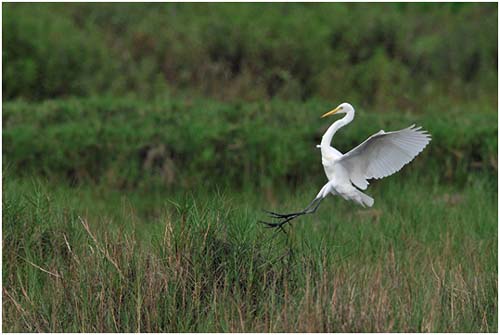
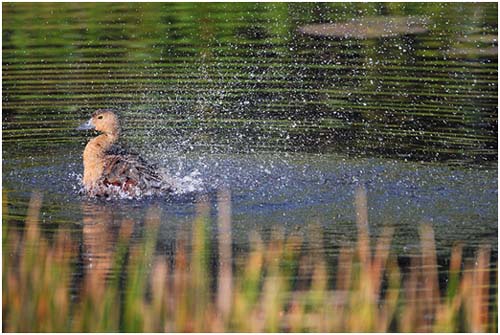


- Details
- Denis Giles
- Hits: 1851
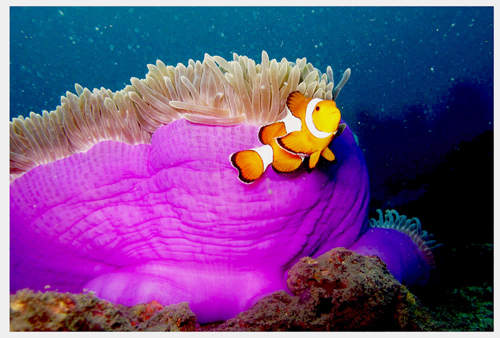
A famous Disney animation movie introduced the underwater world through a movie, Finding Nemo. The movie was well received and Nemo, the clown fish, received a lot of attention, not only with children but also with grown ups .
The habitat of Nemo is coral reef ecosystem, which is a colony of individual corals. The coral animal or polyp has a simple gut that opens at one end and a mouth surrounded by tentacles. These tentacles live in association with algae called zooxanthallae. They form a calcium carbonate structure, which is the main skeleton of the reefs. Corals thrive in bright, sunlit, nutrient-rich areas and provide habitat for thousands of organisms including fish and a variety of other marine life—from large mammals to tiny shells.
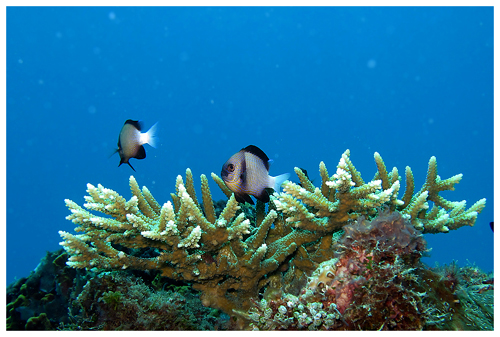
However over the recent years this ecosystem has been threatened due to destructive fishing practices, pollution and their sensitivity to global climate change. In Andaman and Nicobar islands, the reefs have a history of suffering. In 2004 there was a massive tsunami, which impacted the reefs. At some sites, coral reefs were broken into chunks while in others, suffocated by piles of mud and debris. Just when reefs had begun to recover, they were affected by yet another natural disaster—the bleaching of 2010.
The bleaching or whitening of corals occurs when there is sudden increase in sea-surface temperature. Coral animals are sensitive to temperature changes and require warm water between 25-27° C to thrive. When temperature increases, there is a breakdown of the symbiotic relationship between corals and algae resulting in death of the reefs.
Certain areas got heavily affected whereas few reef areas survived the bleaching. Why a few areas survived, while others got affected is interesting; and understanding the processes and mechanism of bleaching could help managers to concentrate their efforts on areas that are naturally resilient to bleaching.

Currently, Andaman Nicobar Islands’ Environmental Team (ANET) runs a project supported by Wildlife Conservation Society is conducting in-depth research to unravel the mystery of why a few reefs survived this bleaching event while the others didn’t. By conducting a series of reef surveys and comparing the various levels of destruction and resilience, we will be able to get a glimpse into this complex event. This will allow us to understand Nemo’s habitat – the coral reef system better so that we can begin taking steps to protect it. While this may not directly result in reversing the effects caused by the bleaching, it can certainly lead to better resource planning and management such as, reducing the man made impacts like habitat destruction, pollution, overfishing and improper disposal of garbage, giving hope to the future of the reefs.
- Vardhan Patankar